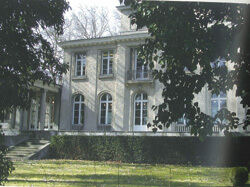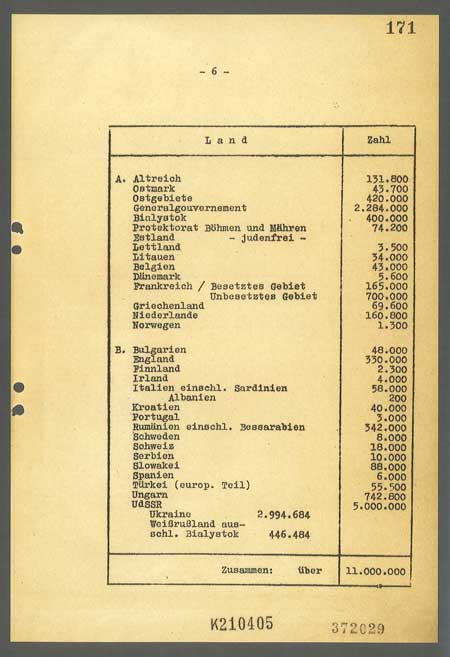
German Christians to mark 70th anniversary of Wannsee at Yad Vashem
Published on: 17.1.2012By: David Parsons
On Thursday and Friday of this week (19-20 January 2012), the International Christian Embassy Jerusalem will be hosting a high-ranking delegation of German and Austrian Christian leaders representing some 30 Protestant denominations and Evangelical ministries for a series of events marking the 70th anniversary of the Wannsee Conference, the infamous meeting of Nazi officials which decided upon the “Final Solution of the Jewish Question.”
The two-day gathering in Jerusalem will be highlighted by a wreath-laying ceremony at Yad Vashem’s Hall of Remembrance to honor the Jewish victims and survivors of the Holocaust, followed by addresses by Israeli cabinet minister Yuli Edelstein and other dignitaries. The delegation of 70 prominent pastors and ministry leaders also will pay a visit to the Knesset, meet with the Chief Rabbinate of Israel, hold a special prayer service at the Western Wall, and attend a memorial concert at Mishkenot Sha´ananim featuring performances by the noted German Christian Music Academy of Stuttgart.
The Wannsee Conference was held on January 20, 1942 at a lakeside villa outside Berlin and was attended by 15 high-ranking Nazi bureaucrats who set in motion the implementation of a plan to eradicate the Jews of Europe. The meeting was convened by Reinhard Heydrich, assistant to deputy Nazi leader Heinrich Himmler, who led a discussion on methods to be used for the systematic, industrial murder of all Jews within Germany’s reach. A chart compiled by Adolf Eichmann for the Wannsee Conference listed all of the estimated 11 million Jews of Europe and northwest Africa as potential targets.
“The Nazi officials who deliberated at Villa Wannsee over their ghastly plans for exterminating European Jewry were all well-educated, with at least half of them holding doctorate degrees. Some were also the sons of Protestant ministers, yet not one of them raised any moral objections to this heinous plot,” noted Dr. Jürgen Bühler, the Executive Director of the International Christian Embassy Jerusalem. “We are here to continue the repentance of our nation for this enormous crime by those who committed mass murder in the name of a wicked ideology. The Church in Germany still has so much more to do to amend for our deafening silence in those dark days.”
The high-level delegation from Germany and Austria will be representing some ten million Germans and Austrians from the Protestant, Evangelical, Charismatic and Pentecostal streams of Christianity. The dignitaries include:
Rev. Ingolf Ellßel, Chairman of the Pentecostal European Fellowship
Rev. Siegfried Tomazsewski, European Director of Christ for all Nations
Claus Philippin, President of International Christian Chamber of Commerce-Germany
Hannelore Illgen, representative of the Federation of Pentecostal Churches in Germany
Rev. Gerry Klein, Director of the Bible College at Bad Gandersheim
Karl-Heinz Geppert, Director of the Aki Liebenzell Communities
Martin Baron, prominent Christian Businessman and Author
Karl Klanner, National Director of ICEJ-Austria
Gottfried Bühler, National Director of ICEJ-Germany
Dietmar Kern, Board Member of Initiative 27 January, Christians for Israel-Germany
Friedemann Meussling, Director of the Christian Music and Art Academy of Stuttgart
Historic Background on the Wannsee Conference
On the 70th Anniversary of the infamous Wannsee Conference, German Christian leaders will be gathering in Jerusalem to honor the Jewish victims and survivors of the Nazi genocide and to condemn the rise of neo-Nazism.

The infamous Wannsee Conference took place at a lakeside villa outside Berlin where, on January 20, 1942, a small group of 15 senior Nazi bureaucrats set in motion the implementation of the “Final Solution of the Jewish Question.” This involved a plan developed by Reinhard Heydrich, assistant to deputy Nazi leader Heinrich Himmler, to systematically murder not just those Jews under Nazi occupation, but all of the estimated 11 million Jews of Europe and northwest Africa.
The passing of 70 years since Wannsee comes at a time when Germany has been shocked by news of the arrest of a militant neo-Nazi terror cell which is suspected of a string of racist murders and bank robberies across the country over the past decade. Chancellor Angela Merkel has described the exposure of the radical right-wing gang as a “disgrace” which has brought “shame” on the nation.
In this context, German Christian leaders have come to Jerusalem on the occasion of the 70th Anniversary of the Wannsee Conference to deliver a critical message to the world that the abhorrent evil of Nazism represented by the cold and calculating decision taken at this gathering must never be allowed to rise again. They will also be honoring the Jewish victims and survivors of the Holocaust at a special series of events at Yad Vashem and at the International Christian Embassy Jerusalem.
The dark legacy of Wannsee
The Wannsee Conference was a meeting of 15 senior Nazi officials held at a plush villa on Lake Wannsee just outside of Berlin on 20 January 1942. The meeting was convened by Reinhard Heydrich to inform the administrative heads of various government departments with some level of jurisdiction over the Jews that he had been appointed as the chief executor of the “Final Solution to the Jewish question.”
In the course of the meeting, Heydrich presented a plan, presumably approved by Adolf Hitler, for the deportation of the Jewish populations of Europe and French North Africa (Morocco, Algeria, and Tunisia) to German-occupied areas in eastern Europe, and the use of the Jews fit for labor on road-building projects, in the course of which they were expected to eventually die. According to the recorded minutes of the Wannsee Conference, any surviving remnant would be annihilated after completion of the road projects. This initial plan was soon altered as subsequent events unfolded during the war. When Soviet and Allied forces began pushing back the German lines, Nazi leaders decided to accelerate the extermination process and most of the Jews of German-occupied Europe were sent to death camps or concentration camps, or killed where they lived. Nonetheless, the Wannsee Conference stands as the clearest single evidentiary proof on which the entire Nazi leadership can be indicted for a collective genocidal plot to eradicate all of European Jewry.
In the months leading up to Wannsee, German forces invading the Soviet Union had made rapid advances to the gates of Moscow and a euphoric Nazi leadership began to discuss how to deal with the four million Jews of Eastern Europe which had fallen under German control. Shedding any moral restraints, Hitler and his chief lieutenants, Herman Göring and Heinrich Himmler, deliberated over the most practical “solution” to the “Jewish question.” Although no written order by Hitler to exterminate all Jews has ever been found, certain comments he made around this time made it clear he wanted to rid them from his realm. Based on this understanding, Göring gave written authorization to Reinhard Heydrich, chief of the Reich Main Security Office (RSHA), to “make all necessary preparations” for a “total solution of the Jewish question.”
At that moment Heydrich was directing the Einsatzgruppen, the roving Nazi death squads which were already slaughtering tens of thousands of Jews in the newly conquered Soviet territories. He viewed his task as ascertaining and then overseeing a more efficient method for exploiting Jewish labor on the way to working and starving them to death.
But then in late 1941, the Soviets launched an effective counterattack outside Moscow, the Japanese bombed Pearl Harbor, the United States joined the fray, and the Nazi hierarchy realized the war would last longer than expected. There would not be enough supplies to feed everyone in the conquered Soviet territories, so discussions turned from the “evacuation” of Jews to their “extermination.” It is likely that a decision was made at around the time of the stall outside Moscow. On December 18, Himmler met with Hitler and afterwards noted in his appointment book “Jewish question – to be exterminated as partisans.” Heydrich had originally invited the administrative heads to a meeting on December 9 to discuss the logistics of his plan for deporting Jews to forced labor camps. But the meeting had to be postponed, as several invitees were called away last minute to a symbolic gathering of the Nazi party’s top echelons to formally declare war on America. Now armed with different marching orders, Heydrich rescheduled the meeting for January 20, 1942 at a lakeside estate in a suburb of Berlin. His primary aim was to bring together representatives of all affected departments to explain the mechanics of a revised plan he was personally commissioned to oversee by the highest authority of the Third Reich. Heydrich’s six-week postponement gave him an opportunity to broaden the original objective from deportations to one fixed on carrying out the ‘Final Solution.”

The ministries represented included Interior, Justice, the Four Year Plan and Occupied Eastern Territories, as well as the Foreign Office, the Reich Chancellery, and the head of the Gestapo. Heydrich’s right-hand man Adolph Eichmann was to take the minutes.
In preparation for the conference, Eichmann had drafted a list with the estimated numbers of Jews in the various European countries, both those under direct Reich control or occupation as well as those countries that were allied or client states, neutral, or at war with Germany. In total, Heydrich’s plan targeted an estimated 11 million Jews in Europe and parts of northwest Africa under the control of the Vichy French.
Heydrich opened the conference by explaining that “after appropriate prior approval by the Führer, emigration as a possible solution has been superseded by a policy of evacuating Jews to the East.” But he added that this would only be a “provisional” solution, as “practical experience” was already being collected for the “future final solution of the Jewish question.”
Holocaust deniers claim that the Wannsee Conference decided on no more than the “evacuation” of the Jewish population of Europe to the east, with no reference to killing them. In fact, Heydrich made clear the ultimate fate intended for the evacuees:
“The possible final remnant will, since it will undoubtedly consist of the most resistant portion, have to be treated accordingly, because it is the product of natural selection and would, if released, act as the seed of a new Jewish revival.”

Heydrich’s meaning would have been obvious to the conference attendees, as they were all educated men well versed in Nazi terminology. At least eight of the fifteen participants held doctorate degrees. No one raised any moral objections. At most, several sought clarification on whether mixed Jews were to be included.
Heydrich went on to say that in the course of the “practical execution of the final solution,” Europe would be “combed through from west to east.” Afterwards, Eichmann sent copies of the conference minutes, styled the “Wannsee ,” to all the participants. It was not until 1947 that a copy of the minutes was found by an American prosecutor in the Nuremberg trials. The Wannsee minutes, however, do not mention killing. These omissions were not fully understood until the interrogation and trial of Eichmann in Israel in 1962. Eichmann told his questioners that towards the end of the meeting cognac was served, and that after that the conversation became less restrained.
“The gentlemen were standing together, or sitting together,” he said, “and were discussing the subject quite bluntly, quite differently from the language which I had to use later in the record. During the conversation they minced no words about it at all… they spoke about methods of killing, about liquidation, about extermination.”
In his recorded minutes, Eichmann summed up these chilling words in one bland sentence: “In conclusion the different types of possible solutions were discussed.”
